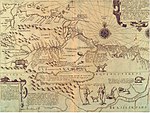Fichier:1656 Sanson Map of Guiana, Venezuela, and El Dorado - Geographicus - Guiane-sanson-1656.jpg

Taille de cet aperçu : 770 × 600 pixels. Autres résolutions : 308 × 240 pixels | 617 × 480 pixels | 986 × 768 pixels | 1 280 × 997 pixels | 2 560 × 1 994 pixels | 4 000 × 3 115 pixels.
Fichier d’origine (4 000 × 3 115 pixels, taille du fichier : 3,32 Mio, type MIME : image/jpeg)
Historique du fichier
Cliquer sur une date et heure pour voir le fichier tel qu'il était à ce moment-là.
| Date et heure | Vignette | Dimensions | Utilisateur | Commentaire | |
|---|---|---|---|---|---|
| actuel | 24 mars 2011 à 01:46 |  | 4 000 × 3 115 (3,32 Mio) | BotMultichillT | {{subst:User:Multichill/Geographicus |link=http://www.geographicus.com/P/AntiqueMap/Guiane-sanson-1656 |product_name=1656 Sanson Map of Guiana, Venezuela, and El Dorado |map_title=Partie de Terre Ferme ou sont Guiane et Caribane, augmentée et corrigée s |
Utilisation du fichier
La page suivante utilise ce fichier :
Usage global du fichier
Les autres wikis suivants utilisent ce fichier :
- Utilisation sur ar.wikipedia.org
- Utilisation sur de.wikipedia.org
- Utilisation sur en.wikipedia.org
- Utilisation sur gcr.wikipedia.org
- Utilisation sur hu.wikipedia.org
- Utilisation sur it.wikipedia.org
- Utilisation sur la.wikipedia.org
- Utilisation sur ru.wikipedia.org
- Utilisation sur uk.wikipedia.org
- Utilisation sur www.wikidata.org

